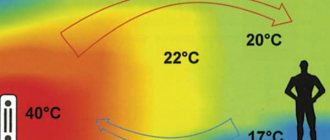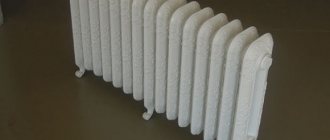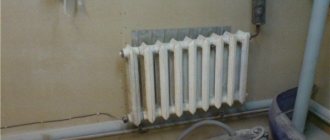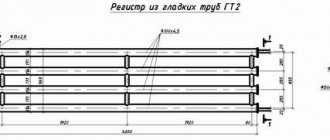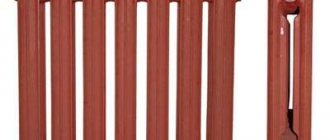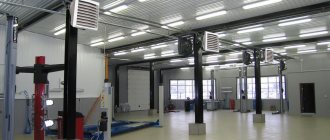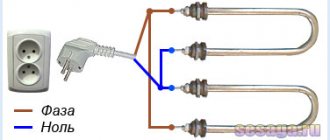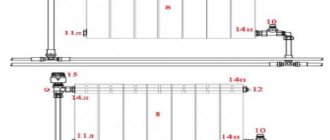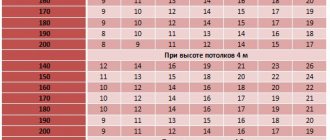Calculation of the number of sections of heating radiators by area calculator. Selection of heating power
When selecting a heating scheme for a small private house, it is this indicator that is decisive.
To calculate sections of bimetallic heating radiators by area, you need to determine the following parameters:
- the amount of necessary compensation for heat losses;
- total area of the heated room.
In construction practice, it is customary to use the first indicator in the given form as 1 kW of power per 10 square meters, i.e. 100 W/m2. Thus, the ratio for calculation will be the following expression:
N = S x 100 x 1.45,
where S is the total area of the heated room, 1.45 is the coefficient of possible heat loss.
If we look at a specific example of calculating the heating power for a room of 4x5 meters, it will look like this:
- 5 x 4 = 20 (m2);
A typical place to install a radiator is under a window, so we use two radiators of the same power of 1450 W. This indicator can be influenced by adding or reducing the number of sections installed in the battery. It should be taken into account that the power of one of them is:
- for bimetallic ones with a height of 50 centimeters - 180 watts;
- for cast iron radiators – 130 watts.
Therefore, you will need to install: bimetallic – 1450: 180 = 8 x2 = 16 sections; cast iron: 1450: 130 = 11.
When using glass bags, heat loss on windows can be reduced by approximately 25%.
Calculation of sections of bimetallic heating radiators by area gives a clear initial idea of their required quantity.
Types of radiators
The process of heating the air and maintaining its sufficient temperature depends on the batteries - metal, size, connection to the complex and their placement. Before calculating the number of radiator sections, you will need to find out the metal of manufacture.
Model range Source www.chipak71.ru
Indicators of various metals:
- A 350 aluminum - 138 W;
- A 500 made of aluminum - 185 W;
- S 500 made of aluminum – 205 W;
- L 350 made of bimetal – 130 W;
- L 500 made of bimetal – 180 W;
- Made of cast iron - 160 W.
Batteries are grouped according to their center length:
- 200 mm;
- 350 mm;
- 500 mm;
- 600 mm.
Steel
This type of coolant is characterized by its relatively low cost and aesthetic appearance. The design is integral and the number of sections is not adjustable. Steel walls are thin and require anti-corrosion protection. During operation, protection against water hammer and mechanical damage is necessary, since the seams can leak. Considering the low heat capacity of the structure, installing it in an apartment is impractical. In a private building, this option is more acceptable, since it is possible to independently regulate the degree of heating of the coolant.
Traditional equipment Source i.ytimg.com
Cast iron
Models with maximum heat transfer. Unlike Soviet radiators, modern ones are presented in decent design options, while retaining their positive properties.
This type of battery is practical and convenient:
- the number of sections can be adjusted;
- water hammers are not dangerous for them;
- the walls of the sections are little susceptible to corrosion processes;
- The device is suitable for any coolant.
Cast iron batteries are heavy and require high-quality installation and reliable fastening (wall-mounted and floor-mounted options are available).
In addition, batteries take a long time to heat up.
Aluminum
With high heat transfer, aluminum structures are lightweight. The appearance is elegant and varied, which allows them to be installed in any room. The structures can be either solid or prefabricated, consisting of several sections.
Since aluminum is susceptible to oxygen corrosion, the battery requires appropriate anti-corrosion protection. If available, this type of radiator surpasses all others in terms of performance characteristics.
Aluminum under the window Source pro-remont.org
The devices are installed in the private sector due to increased exposure to water hammer. With central heating this cannot be resisted.
Bimetallic
Made from two layers. External aluminum, has high heat dissipation. The second is made of an alloy that is not destroyed by corrosion. This design ensures long-term operation. However, the cost of these models is quite high, so it is important how to calculate the number of bimetallic radiator sections per room. They are characterized by stronger thermal conductivity than cast iron.
Aluminum heating radiators, calculation of the number of sections. Simple calculation
Table for calculating the required number of sections depending on the area of the heated room and the power of one section.
Calculating the number of sections of heating batteries using a calculator gives good results. Let's give a simple example for heating a room of 10 square meters. m - if the room is not corner and has double glazed windows, the required thermal power will be 1000 W. If we want to install aluminum batteries with a heat dissipation of 180 W, we will need 6 sections - we simply divide the resulting power by the heat dissipation of one section.
Accordingly, if you buy radiators with a heat output of one section of 200 W, then the number of sections will be 5 pieces. Will the room have high ceilings up to 3.5 m? Then the number of sections will increase to 6 pieces. Does the room have two external walls (corner room)? In this case, you need to add another section.
You also need to take into account the thermal power reserve in case of a too cold winter - it is 10-20% of the calculated one.
You can find out information about the heat transfer of batteries from their passport data. For example, the number of sections of aluminum heating radiators is calculated based on the heat transfer of one section. The same applies to bimetallic radiators (and cast iron ones, although they are not removable). When using steel radiators, the rated power of the entire device is taken (we gave examples above).
Calculation depending on the type of radiator
When studying the components of heating systems in an online store, the calculator calculates heating radiators per area online.
Data is provided for each model. The figure is sometimes given not in W, but as coolant flow. You can recalculate: 1 l/min is considered as 1 kW of power.
Single pipe system
There are some special features when using a system with a single-pipe connection. A cooler coolant reaches the device installed further. In order not to count the temperature individually, a simplified procedure is used.
If you have a single-pipe system in your home, the Gibax brand has special connection modules Radiplekt Therm and Radiplekt, which, thanks to the minimum number of connections, will make the system as reliable as possible. These are modules with automatic or manual temperature modes. Also, these modules will help you maintain optimal indoor air temperature thanks to automatic or manual control.
One-piece design Source highlogistic.ru
First, calculate as for a two-pipe system, and then add the required number of radiator sections. The percentage of heat reduction at the connecting joints determines the number of additional sections. The drop in heating temperature is typically assumed to be 20% at a more distant junction.
Calculation of heating radiators in a private house. Calculation of the number of radiators in a private house
If for apartments it is possible to take the average parameters of heat consumption, since they are designed for standard room dimensions, then in private construction this is incorrect. After all, many owners build their houses with ceiling heights exceeding 2.8 meters, in addition, almost all private premises are corner, so heating them will require more power. In this case, calculations based on the area of the room are not suitable: you need apply the formula taking into account the volume of the room and make adjustments by applying coefficients for reducing or increasing heat transfer. The values of the coefficients are as follows:
- 0.2 - the resulting final power number is multiplied by this indicator if multi-chamber plastic double-glazed windows are installed in the house.
- 1.15 – if the boiler installed in the house operates at its capacity limit. In this case, every 10 degrees of heated coolant reduces the power of the radiators by 15%.
- 1.8 is the magnification factor that needs to be applied if the room is corner and has more than one window.
To calculate the power of radiators in a private house, the following formula is used:
P = V x 41, where
- V – volume of the room;
- 41 – average power required to heat 1 sq. m of a private house.
Calculation example If you have a room of 20 sq. m (4x5 m - the length of the walls) with a ceiling height of 3 meters, then its volume is easy to calculate: 20 x 3 = 60 W. The resulting value is multiplied by the power accepted by the standards: 60 x 41 = 2460 W - this is how much heat is required to heat the area in question. Calculation of the number of radiators comes down to the following (taking into account that one radiator section emits 160 W on average, and their exact data depends on the material from which the batteries are made): 2460 / 160 = 15.4 pieces. Let's assume that a total of 16 sections are needed, then There is a need to purchase 4 radiators of 4 sections for each wall or 2 of 8 sections. At the same time, one should not forget about the adjustment coefficients.
Rooms with standard ceiling heights
The number of heating radiator sections for a typical house is calculated based on the area of the rooms. The area of a room in a typical house is calculated by multiplying the length of the room by its width. To heat 1 square meter, 100 W of heating device power is required, and to calculate the total power, you need to multiply the resulting area by 100 W. The resulting value means the total power of the heating device. The documentation for the radiator usually indicates the thermal power of one section. To determine the number of sections, you need to divide the total power by this value and round the result up.
A room with a width of 3.5 meters and a length of 4 meters, with a normal ceiling height. The power of one radiator section is 160 W. You need to find the number of sections.
- We determine the area of the room by multiplying its length by its width: 3.5·4 = 14 m2.
- We find the total power of heating devices 14·100 = 1400 W.
- Find the number of sections: 1400/160 = 8.75. We round up to a higher value and get 9 sections.
You can also use the table:
Table for calculating the number of radiators per M2
For rooms located at the end of the building, the estimated number of radiators must be increased by 20%.
Rooms with a ceiling height of more than 3 meters
The number of heating sections for rooms with a ceiling height of more than three meters is calculated based on the volume of the room. Volume is the area multiplied by the height of the ceilings. To heat 1 cubic meter of room, 40 W of thermal power of the heating device is required, and its total power is calculated by multiplying the volume of the room by 40 W. To determine the number of sections, this value must be divided by the capacity of one section according to the passport.
A room with a width of 3.5 meters and a length of 4 meters, with a ceiling height of 3.5 m. The power of one radiator section is 160 W. It is necessary to find the number of sections of heating radiators.
- Find the area of the room by multiplying its length by its width: 3.5·4 = 14 m2.
- We find the volume of the room by multiplying the area by the height of the ceilings: 14·3.5 = 49 m3.
- We find the total power of the heating radiator: 49·40 = 1960 W.
- Find the number of sections: 1960/160 = 12.25. Round up and get 13 sections.
You can also use the table:
As in the previous case, for a corner room this figure must be multiplied by 1.2. It is also necessary to increase the number of sections if the room has one of the following factors:
- Located in a panel or poorly insulated house;
- Located on the first or last floor;
- Has more than one window;
- Located next to unheated rooms.
In this case, the resulting value must be multiplied by a factor of 1.1 for each factor.
Corner room with a width of 3.5 meters and a length of 4 meters, with a ceiling height of 3.5 m. Located in a panel house, on the first floor, it has two windows. The power of one radiator section is 160 W. It is necessary to find the number of sections of heating radiators.
- Find the area of the room by multiplying its length by its width: 3.5·4 = 14 m2.
- We find the volume of the room by multiplying the area by the height of the ceilings: 14·3.5 = 49 m3.
- We find the total power of the heating radiator: 49·40 = 1960 W.
- Find the number of sections: 1960/160 = 12.25. Round up and get 13 sections.
- We multiply the resulting amount by the coefficients:
Corner room - coefficient 1.2;
Panel house – coefficient 1.1;
Two windows - coefficient 1.1;
First floor - coefficient 1.1.
Thus, we get: 13·1.2·1.1·1.1·1.1 = 20.76 sections. We round them up to a larger integer - 21 sections of heating radiators.
When making calculations, it should be borne in mind that different types of heating radiators have different thermal output. When choosing the number of heating radiator sections, you must use exactly the values that correspond to the selected type of battery.
In order for the heat transfer from radiators to be maximum, it is necessary to install them in accordance with the manufacturer’s recommendations, observing all the distances specified in the passport. This promotes better distribution of convective flows and reduces heat loss.
- Diesel heating boiler consumption
- Bimetallic heating radiators
- How to calculate heat for heating a house
- Calculation of reinforcement for the foundation
Thermal power of 1 section
As a rule, manufacturers indicate average heat transfer rates in the technical characteristics of heaters. So for heaters made of aluminum it is 1.9-2.0 m2. To calculate how many sections are required, you need to divide the area of the room by this coefficient.
For example, for the same room with an area of 16 m2, 8 sections will be required, since 16/2 = 8.
These calculations are approximate and cannot be used without taking into account heat loss and the actual conditions for placing the battery, since you can get a cold room after installing the structure.
To get the most accurate indicators, you will have to calculate the amount of heat that is needed to heat a specific living space. To do this, you will have to take into account many correction factors. This approach is especially important when calculating aluminum heating radiators for a private home is required.
The formula needed for this is as follows:
KT = 100W/m2 x S x K1 x K2 x K3 x K4 x K5 x K6 x K7
- KT is the amount of heat that a given room requires.
- S – area.
- K1 – designation of the coefficient for a glazed window. For standard double glazing it is 1.27, for double glazing it is 1.0, and for triple glazing it is 0.85.
- K2 is the coefficient of the wall insulation level. For a non-insulated panel it = 1.27, for a brick wall with one layer of masonry = 1.0, and for two bricks = 0.85.
- K3 is the ratio of the area occupied by the window and the floor. When between them:
- 50% - coefficient is 1.2;
- 40% — 1.1;
- 30% — 1.0;
- 20% — 0.9;
- 10% — 0.8.
- K4 is a coefficient that takes into account the air temperature according to SNiP on the coldest days of the year:
- +35 = 1.5;
- +25 = 1.2;
- +20 = 1.1;
- +15 = 0.9;
- +10 = 0.7.
- K5 indicates adjustment in the presence of external walls. For example:
- when she is alone, the indicator is 1.1;
- two external walls – 1.2;
- 3 walls – 1.3;
- all four walls – 1.4.
- K6 takes into account the presence of a room above the room for which calculations are made. If available:
- unheated attic - coefficient 1.0;
- heated attic – 0.9;
- living room – 0.8.
- K7 is a coefficient that indicates the height of the ceiling in the room:
- 2.5 m = 1.0;
- 3.0 m = 1.05;
- 3.5 m = 1.1;
- 4.0 m = 1.15;
- 4.5 m = 1.2.
If you apply this formula, you can foresee and take into account almost all the nuances that may affect the heating of the living space. Having made a calculation using it, you can be sure that the result obtained indicates the optimal number of aluminum radiator sections for a particular room.
If you decide to install aluminum radiators, it is important to know the following:
Whatever principle of calculation is undertaken, it is important to do it as a whole, since correctly selected batteries allow you not only to enjoy warmth, but also significantly save on energy costs. The latter is especially important in the context of constantly rising tariffs
Calculation example
If you calculate how many sections of an aluminum radiator are needed for a room with an area of 20 m2 at a rate of 100 W/m2, then adjustment coefficients for heat loss should also be made:
- each window adds 0.2 kW to the indicator;
- the door “costs” 0.1 kW.
If it is assumed that the radiator will be placed under the window sill, then the correction factor will be 1.04, and the formula itself will look like this:
Q = (20 x 100 + 0.2 + 0.1) x 1.3 x 1.04 / 72 = 37.56
- the first indicator is the area of the room;
- the second is the standard number of W per m2;
- the third and fourth indicate that the room has one window and one door;
- the next indicator is the heat transfer level of the aluminum radiator in kW;
- the sixth is a correction factor regarding the location of the battery.
Everything should be divided by the heat output of one heater fin. It can be determined from the table from the manufacturer, which shows the heating coefficients of the carrier in relation to the power of the device. The average for one edge is 180 W, and the adjustment is 0.4. Thus, multiplying these numbers, it turns out that one section produces 72 W when heating water to +60 degrees.
Since rounding is done upward, the maximum number of sections in an aluminum radiator specifically for this room will be 38 fins. To improve the performance of the structure, it should be divided into 2 parts of 19 ribs each.
Find out useful information about aluminum batteries on our website:

